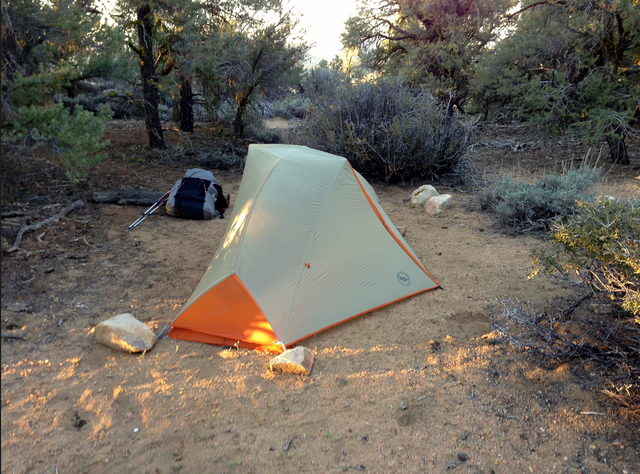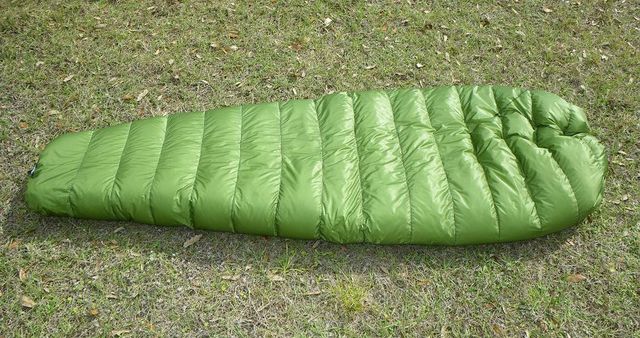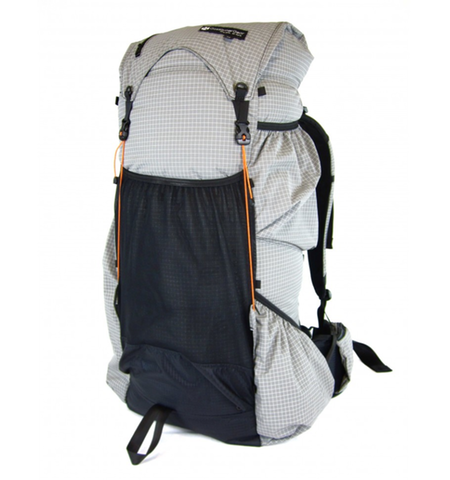Taking a cue from Amelia's first post-hike gear review, I am breaking my reviews up into slightly more manageable chunks. This first one will be about the big three of backpacking: the pack, the sleeping bag, and the tent. All totaled, these three items were 4.9 pounds of my base weight and cost $975.00. Definitely earning the name Big Three as that is a third of my base weight and about half of my gear cost.

I originally started out with a Tarptent Contrail, which Amelia greatly loved, but I found myself becoming more and more annoyed during the first couple weeks thanks to the wind storms and poor staking conditions; to the point that there were situations where I really should have put up my tent but I did not want to trouble myself. Not a good sign, so I ordered the Big Agnes Copper Spur UL 1 at the Big Bear Lake hostel and had it delivered to The Saufleys in Agua Dulce.
Chose the Copper Spur for a few reasons. It is a free standing tent, has a side vestibule (compared to the front vestibule on the Fly Creek), and is longer than the Fly Creek (I am 6'1"). The weight was around half a pound heavier than the Contrail, but I got a tent that would not collapse under wind or snow, had slightly more head room, and if it was a gorgeous night and I just wanted bug protection I could still see the moon, stars, and the occasional meteor shower. Was pleased with my choice.
Pros: Sturdy, free-standing, easy to stake, simple setup, great for buggy environments, dries super-quick, and tough.
Cons: Bit heavier than most UL options, comfortable but not roomy for a large guy, rather pricey if you do not have a famous REI 20% coupon.
Bottom Line: Recommended. I was happy with my choice. Might be tempted to try another ultralight option in the future though (ex: Hexamid), if I had spare cash, as the weight did bug me a bit.
ZPacks 20 Degree Down Sleeping Bag (Wide, X-Long)

Like many thru-hikers, I did my research and was intending to use a Western Mountaineering Ultralite down sleeping bag. Right towards the end of the trip planning phase, while reading Yet Another Hiking Blog (YAHB), I discovered ZPacks. The Western Mountaineering Ultralite long was 31 oz, while the ZPacks Wide, X-Long was only 21.7 oz. And it was cheaper. The ZPacks bag is basically what happens when a down quilt and a down sleeping bag have a baby, with a couple genetic enhancements. It was fantastic.
The only real downside really had to do with the trail itself. Quite often a 20 degree bag was overkill in the desert. And yet, three days later that bag could be indispensable when a freezing cold night happened. Washington rained on us almost a third of the times, so I protected my sleeping bag by putting it inside a trash bag inside a cuben sack inside the trash compactor bag lined part of my pack. Even with that, a handful of times it got a bit damp while unstuffed in my tent.
Pros: Warm, lightweight, compressible, did not cover my head (I suffer from anti-mummy tendencies and prefer a hat), worked great as a blanket. When it was really cold, it was AMAZING!
Cons: Expensive. Bit too warm for about half of California. Constant vigilance required in Washington to keep it dry.
Bottom Line: Recommended. If I had to do it again, I might consider using a higher degree bag and then carrying a liner for the Sierras and Washington.

Sadly, I do not have a good shot of myself using this backpack in the wild. Typically I was carrying it on my back, so I suppose that is not completely unexpected. Stock photo to the rescue!
Probably one of the pieces of ultralight gear I was most skeptical about. Currently, I have four other backpacks that I use for all variety of purposes: guiding, mountaineering, quick summit hops from basecamp, et cetera. For me a pack needs to hold the right amount of gear comfortably for days while making my gear easily accessible. Surely a pack that ways less than 2 pounds could not handle all of the trials of a thru-hike. I was wrong. Except for when it was overloaded with a bear canister and/or 6-7 days worth of food, it worked perfectly. It was meant to carry 35 pounds or less, and I think that is spot on. Go over that and your pack (and you) will suffer for it. The aluminum stays and padding is just not capable of handling more than that amount of weight or strain. You have been warned.
By the way, its removable pad for sitting is a great idea. I used it constantly during breaks and meals. So much in fact that I eventually had to replace it in Echo Lake. Hat tip to Gossamer Gear for that idea.
Pros: Lightweight, cheap, durable (2668+ miles and still usable), perfect volume for a thru-hiker.
Cons: Both grommets came out and had to be repaired with floss and needle. Not ideal for heavy loads in the Sierras. I am hard on my gear so I tried to be a bit more gentle with this pack to insure it survived the journey.
Bottom Line: Recommended. They informed me via email that they know about the grommet issue and are addressing it. For the Sierras, I think I would have mailed myself one of my heavier and more sturdier packs (Osprey Atmos?) to make the large loads more comfortable.